Outdoor events after dark, present one of the most challenging of assignments; and coping with the light – or lack of it – is at the top of the list of problems you'll face. The photograph here is of the Kirkudbright Tattoo. A wonderful event of Scottish pipers, marching and music. The shot was planned some days before the event. I secured the use of an upstairs window overlooking the street where the action would take place. From this vantage point I could see everything that happened below and had the backdrop of the castle. The camera was mounted on a heavy tripod which extended out of the window. The ISO was pushed up to 800 and an exposure of 1/8sec at f4 was used. With such a slow shutter speed it was inevitable that there would be some movement in the marching pipers, but as they are marching almost directly towards the camera, this is hardly noticeable. The important aim was to capture the atmosphere and splendour of an outdoor night event in the street.
The photograph here is of the Kirkudbright Tattoo. A wonderful event of Scottish pipers, marching and music. The shot was planned some days before the event. I secured the use of an upstairs window overlooking the street where the action would take place. From this vantage point I could see everything that happened below and had the backdrop of the castle. The camera was mounted on a heavy tripod which extended out of the window. The ISO was pushed up to 800 and an exposure of 1/8sec at f4 was used. With such a slow shutter speed it was inevitable that there would be some movement in the marching pipers, but as they are marching almost directly towards the camera, this is hardly noticeable. The important aim was to capture the atmosphere and splendour of an outdoor night event in the street.
There are broadly three methods of dealing with the difficulties that low light levels present.
1
Put your camera on a tripod and use a slow shutter speed. You will not need to bother about using a fast ISO, and you will be free to use a smaller aperture with its greater depth of field to get more of the scene in focus. Good, you should have a sharp picture of the overall scene - the buildings and surroundings, and that slow ISO will give you fine quality. But hang on, that’s okay if nothing within the scene moves. If it does, your long exposure may render it as a blur.
2
Whack up the ISO as high as possible, maybe ISO 1600, and use the fastest possible shutter speed to freeze the action. Bearing in mind the low light conditions, you may also have to use a wide aperture to achieve this fast shutter speed, this means you will have less depth of field, and the image will be of poorer quality due to the faster ISO. It’s all a compromise, really. However, this method can achieve some wonderfully atmospheric pictures using what little natural light is available. It's a useful technique.
3
Use eletronic flash. This can freeze any action, but the downside is that it is likely to eradicate any atmosphere with its harsh, ‘press photo’ results… and remember - when shooting with flash outside at night any distant background may become totally black because the light of the flash will not carry that far.
In part 2… I'll show you how to combine some of these methods
1 Dec 2007
How to photograph night events. Part 1
Subscribe to:
Post Comments (Atom)


No comments:
Post a Comment